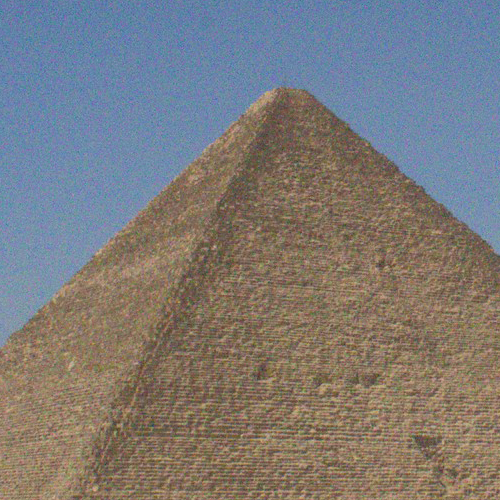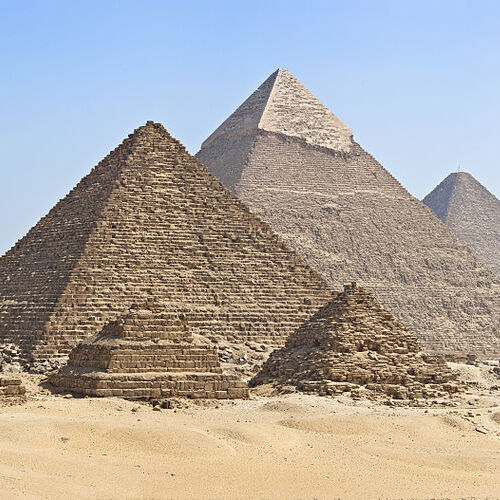No other nation in the world says ‘Welcome’ as often as the Egyptians, and every time, they mean it. While the ancient civilization of Egypt continues to amaze, contemporary Egyptians are equally remarkable.
Pyramid Of Khafre
Khafre's Pyramid: A Monumental Masterpiece
Khafre, a pharaoh of ancient Egypt, envisioned his pyramid standing proudly beside his father’s on the illustrious Giza Plateau. Nestled southwest of the Great Pyramid, Khafre’s monument is a testament to timeless craftsmanship, resilient against the trials of centuries.
What sets Khafre’s pyramid apart is its breathtaking synergy with the enigmatic Great Sphinx, a mystical guardian of these ancient grounds. The Sphinx, a colossal embodiment of regal mystique, gazes eternally towards Khafre‘s pyramid, a silent testament to the enigmatic allure of the Giza Plateau.
While slightly smaller in scale than his father’s monumental pyramid, Khafre’s creation evokes an illusion of grandeur thanks to its elevated position on the plateau, graced with a steeper slope. Among the pyramids that have endured through millennia, Khafre’s stands as the best-preserved, its majestic height largely intact, preserving the aura of antiquity.
In 1816, a pivotal moment in modern history unfolded as the intrepid explorer Belzoni became the first to step foot within Khafre’s pyramid. With unyielding determination, Belzoni discovered the upper entrance and the labyrinthine chambers beneath. In honor of his groundbreaking discovery, English Colonel Fitzclarence immortalized Belzoni’s name on the pyramid’s upper entrance.
Khafre’s pyramid, constructed atop a flat terrace, boasts a core of irregularly shaped limestone blocks, remnants of an era when thieves had stripped the casing of Tura limestone. These enduring limestone remnants echo the grandeur of ancient times. Red granite graces the southern flank of the pyramid, a testament to the enduring allure of this timeless structure.
The vertical axis of Khafre’s pyramid houses his burial chamber, a modest pit hewn within the bedrock and roofed with limestone blocks, akin to his father’s pyramid, designed to withstand the immense stone weight above.
Etchings on the burial chamber’s southern wall bear testimony to Belzoni’s discovery in Italian, a tribute to his Italian heritage. Further exploration uncovered inscriptions from the 12th century A.D. on the west wall, adding layers to the pyramid’s storied history.
Within the burial chamber lies Khafre’s red granite sarcophagus, partially sunken into the chamber floor. Adjacent to it, a pit suggests the resting place of a canopic chest, once cradling the pharaoh’s internal organs before mummification.
Khafre’s complex, rich in history, once featured a satellite pyramid, believed to serve a cultic purpose rather than for burials. The expansive mortuary temple, a testament to architectural brilliance, sprawls eastward from the pyramid, its limestone pavement delineating the sacred from the secular.
Excavations in 1910 unveiled a treasure trove within the temple—a courtyard, entrance hall, storage rooms, offering hall, and five statue chapels, each a testament to Khafre’s enduring legacy.
A timeworn causeway, stretching 494 meters, links the mortuary temple to the remarkably well-preserved valley temple. Adorned with colossal monoliths of limestone, it remains unrivaled in preservation among valley temples. In 1852, Auguste Mariette rediscovered this temple, originally misidentifying it as the Temple of the Sphinx. It was, in fact, Khafre’s own temple.
Distinguished by lintels and pillars hewn from colossal Aswan granite blocks, the temple boasts a unique and regal allure reminiscent of the Osirion temple in Abydos.
In 1860, amidst excavations of the valley temple, Mariette unearthed seven statues dedicated to Khafre, including a diorite masterpiece adorned with a Horus falcon. Today, this splendid piece of Egyptian art graces the Cairo Museum.
As time continues to unravel the mysteries of Khafre’s reign, the purpose of the valley temple remains a subject of debate. Some conjecture it may have served as a site for embalming rites preceding Khafre’s final journey. Recent discoveries in 1995, including purification tents and subterranean passages, have only deepened the enigma.
Presiding over this magnificent tableau is the Great Sphinx, an iconic sentinel to the north of the temple. Its enigmatic smile and steadfast gaze have sparked countless debates. Some suggest that it was conceived during Khafre’s reign, thus making it Egypt’s earliest colossal statue.
In the heart of the Giza Plateau, where time’s tapestry is woven with threads of history and mystery, Khafre’s pyramid and its enigmatic companions stand, beckoning explorers to unlock the secrets of an ageless past.
Created On April 07, 2020
Updated On July 22 , 2025
Giza Travel Guide



